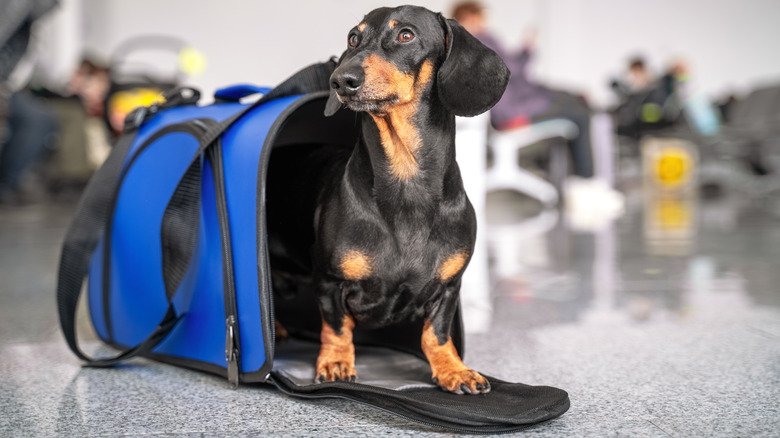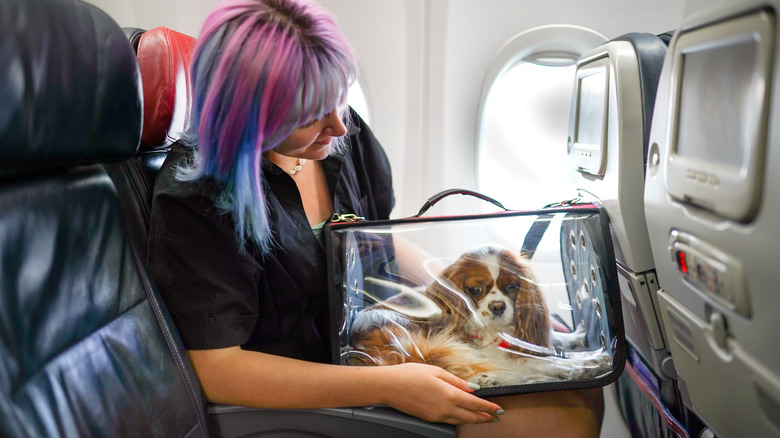What To Know Before Flying With Your Emotional Support Animal
Flying can be an extremely stressful event for some people. This is why traveling with an emotional support animal (ESA) can be essential for people who have anxiety or other mental health issues that require the presence and comfort of an animal.
According to the Americans with Disabilities Act National Network, it's important to make the distinction between service animals (including psychiatric service dogs) and emotional support animals. ESAs are any pet that provides comfort to a person living with a disability and alleviates their symptoms; however, they do not have special training like a service animal.
ESAs have become increasingly popular in recent years as people look for alternative ways to deal with their mental health issues. However, they have also become slightly controversial, too. People have been known to bring animals such as ducks and miniature horses onto planes. While it can be odd to see a small horse trotting down the aisle of your airplane, these animals provide companionship and comfort. However, not all airlines will accept them onboard.
Rules regarding emotional support animals
When flying with an emotional support animal (ESA), it's important to be aware of the rules and regulations set by airlines. And yes, we said airlines, not the Americans with Disabilities Act (ADA), since ESAs are not regulated by the ADA but by the Department of Transportation's (DOT) Air Carrier Access Act (ACAA).
Per the DOT, the ACAA "makes it illegal for airlines to discriminate against passengers because of their disability." What does this mean for ESAs? Well, in most cases the DOT essentially treats ESAs the same as service animals with a few exceptions.
Where ESAs and service animals are similar is in the limitations on what kind of animals you can bring onboard. Any animal can be barred from boarding a flight with a passenger if it's too large for the cabin, poses a risk to passengers or crew, is disruptive to the flight crew's ability to serve other passengers, or is prohibited from entering a country.
The ways ESA and service animals begin to differ, though, is in how they are identified. Airlines are permitted to rely on verbal and visual cues to determine if an animal is a service animal. For ESAs, they can request specific documentation or advanced notice. The documentation cannot be dated more than a year from the day you fly and must include an assessment from a licensed healthcare provider that states the passenger has a mental or emotional disability that requires an ESA.
You can fly with your ESA on these airlines
Not all airlines are created equal when it comes to emotional support animals (ESAs). Despite the Air Carrier Access Act (ACAA) requiring airlines to accept service animals, as of March 2021, it does not protect ESAs and their owners, leaving the decision up to the airlines. As a result, some airlines are considered more accommodating than others.
Unfortunately, most U.S. domestic airlines do not permit ESAs onboard (though many airlines still allow you to travel with a pet either as a carry-on or in a cargo hold). However, there are still a few airlines that accept them, including LatAm Airlines, Volaris, and Westjet. That said, they are limited to certain routes. For example, LatAm Airlines permits ESA dogs on routes to or from Colombia and Mexico and cats to or from Colombia as long as they remain in their carrier. Volaris allows an ESA on routes within and between Mexico, Central, and South America. Currently, you can also bring an ESA on international airlines such as Air France, Asiana Air, and KLM, to name a few, but be sure to check the rules of the specific airline just to be sure.


